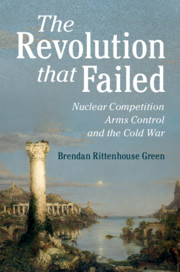Crossref Citations
This Book has been
cited by the following publications. This list is generated based on data provided by Crossref.
Lutsch, Andreas
2020.
The zero option and NATO’s dual-track decision: Rethinking the paradox.
Journal of Strategic Studies,
Vol. 43,
Issue. 6-7,
p.
957.
Graef, Alexander
2021.
Beyond Stability: The politics of conventional arms control in Europe.
Zeitschrift für Friedens- und Konfliktforschung,
Vol. 10,
Issue. 2,
p.
219.
Futter, Andrew
and
Zala, Benjamin
2021.
Strategic non-nuclear weapons and the onset of a Third Nuclear Age.
European Journal of International Security,
Vol. 6,
Issue. 3,
p.
257.
Blagden, David
2021.
When Does Competition Become Conflict? Technology, Geography, and the Offense–Defense Balance.
Journal of Global Security Studies,
Vol. 6,
Issue. 4,
DeMars, William E
2022.
Sacrificial causalities of nuclear weapons: Takashi Nagai and Albert Wohlstetter.
Journal of International Political Theory,
Vol. 18,
Issue. 1,
p.
66.
Craig, Campbell
and
Amadae, S.M.
2023.
The myth of the nuclear revolution: Power politics in the atomic age.
Journal of Strategic Studies,
Vol. 46,
Issue. 1,
p.
212.
Kang, Kyungkook
and
Kugler, Jacek
2023.
Averting Nuclear War.
p.
53.
Renic, Neil C.
2023.
Superweapons and the myth of technological peace.
European Journal of International Relations,
Vol. 29,
Issue. 1,
p.
129.
Suh, Kyungwon
2023.
Nuclear balance and the initiation of nuclear crises: Does superiority matter?.
Journal of Peace Research,
Vol. 60,
Issue. 2,
p.
337.
Talmadge, Caitlin
and
Rovner, Joshua
2023.
The meaning of China’s nuclear modernization.
Journal of Strategic Studies,
Vol. 46,
Issue. 6-7,
p.
1116.
Oskanian, Kevork
2023.
Beyond State and Hegemony: International Orders as Anarchic Meta-Fields.
International Studies Quarterly,
Vol. 67,
Issue. 2,
Demarest, Heidi
Jost, Tyler
and
Schub, Robert
2023.
Bureaucracy and Cyber Coercion.
International Studies Quarterly,
Vol. 68,
Issue. 1,
Zala, Benjamin
2023.
‘No one around to shut the dead eyes of the human race’: Sartre, Aron, and the limits of existentialism in the Nuclear Age.
Review of International Studies,
Vol. 49,
Issue. 5,
p.
795.
Arceneaux, Giles David
2023.
Whether to worry: Nuclear weapons in the Russia-Ukraine war.
Contemporary Security Policy,
Vol. 44,
Issue. 4,
p.
561.
Egeland, Kjølv
2023.
Climate security reversed: the implications of alternative security policies for global warming.
Environmental Politics,
Vol. 32,
Issue. 5,
p.
883.
Rovner, Joshua
2024.
History is written by the losers: Strategy and grand strategy in the aftermath of war.
Journal of Strategic Studies,
p.
1.
Suh, Kyungwon
2024.
Achieving Minimum Deterrence: A New Dyadic Dataset on Strategic Nuclear Weapons Delivery Capabilities.
Journal of Conflict Resolution,
Vol. 68,
Issue. 5,
p.
1017.
Hiim, Henrik Stålhane
2024.
The last atomic Waltz: China’s nuclear expansion and the persisting relevance of the theory of the nuclear revolution.
Contemporary Security Policy,
Vol. 45,
Issue. 2,
p.
239.
Larsen, Even Hellan
2024.
Deliberate Nuclear First Use in an Era of Asymmetry: A Game Theoretical Approach.
Journal of Conflict Resolution,
Vol. 68,
Issue. 5,
p.
849.





